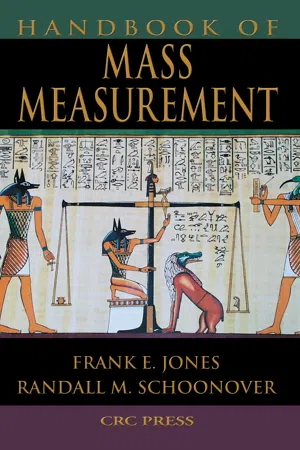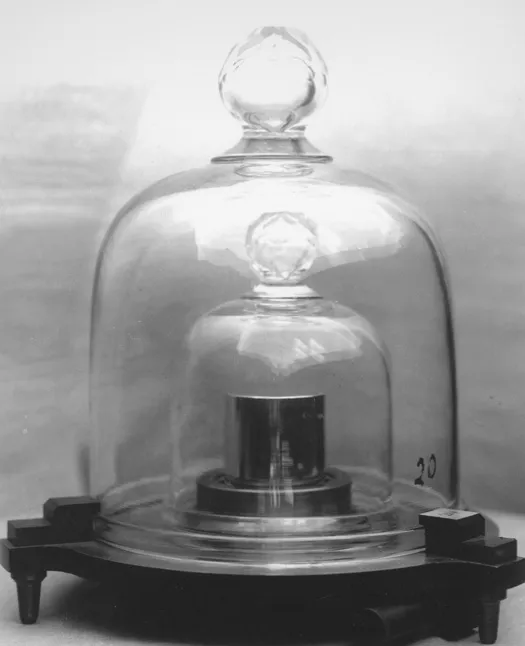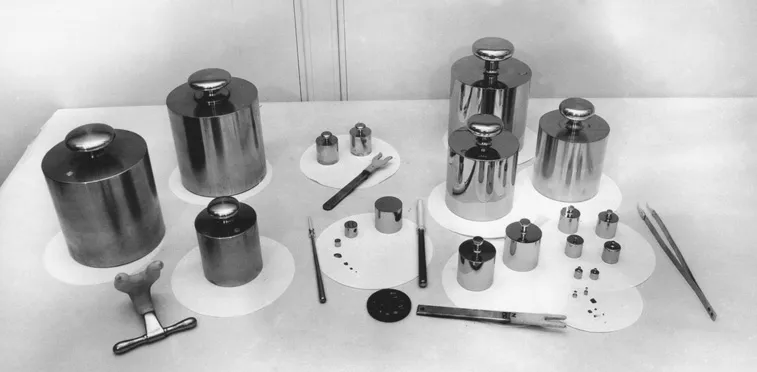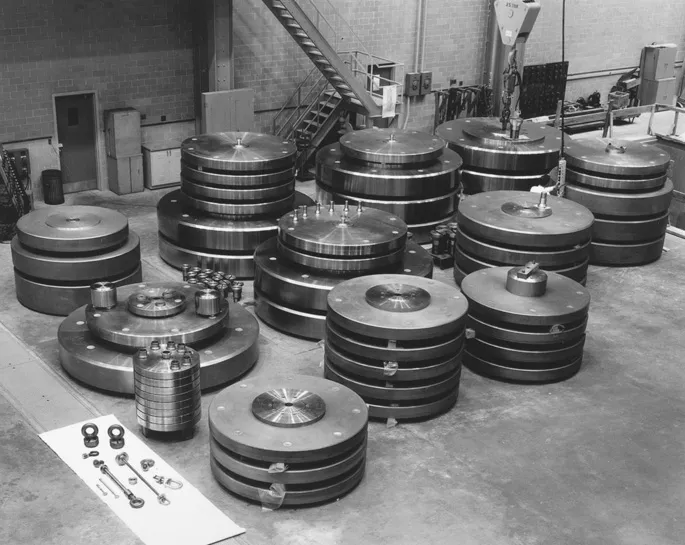
This is a test
- 336 pages
- English
- ePUB (mobile friendly)
- Available on iOS & Android
eBook - ePub
Handbook of Mass Measurement
Book details
Book preview
Table of contents
Citations
About This Book
"How much does it weigh?" seems a simple question. To scientists and engineers, however, the answer is far from simple, and determining the answer demands consideration of an almost overwhelming number of factors.With an intriguing blend of history, fundamentals, and technical details, the Handbook of Mass Measurement sets forth the details
Frequently asked questions
At the moment all of our mobile-responsive ePub books are available to download via the app. Most of our PDFs are also available to download and we're working on making the final remaining ones downloadable now. Learn more here.
Both plans give you full access to the library and all of Perlego’s features. The only differences are the price and subscription period: With the annual plan you’ll save around 30% compared to 12 months on the monthly plan.
We are an online textbook subscription service, where you can get access to an entire online library for less than the price of a single book per month. With over 1 million books across 1000+ topics, we’ve got you covered! Learn more here.
Look out for the read-aloud symbol on your next book to see if you can listen to it. The read-aloud tool reads text aloud for you, highlighting the text as it is being read. You can pause it, speed it up and slow it down. Learn more here.
Yes, you can access Handbook of Mass Measurement by Frank E. Jones,Randall M. Schoonover in PDF and/or ePUB format, as well as other popular books in Mathematics & Mathematics General. We have over one million books available in our catalogue for you to explore.
Information
1
Mass and Mass Standards
1.1 Introduction
1.1.1 Definition of Mass
The following quotation of Condon and Odishaw1 is presented here as a succinct definition of mass: “The property of a body by which it requires force to change its state of motion is called inertia, and mass is the numerical measure of this property.”
1.1.2 The Mass Unit
According to Maxwell,2 “every physical quantity [mass in the present case] can be expressed as the product of a pure number and a unit, where the unit is a selected reference quantity in terms of which all quantities of the same kind can be expressed.” The fundamental unit of mass is the international kilogram. At present the kilogram is realized as an artifact, i.e., an object. Originally, the artifact was designed to have the mass of 1 cubic decimeter of pure water at the temperature of maximum density of water, 4°C. Subsequent determination of the density of pure water with the air removed at 4°C under standard atmospheric pressure (101,325 pascals) yielded the present value of 1.000028 cubic decimeters for the volume of 1 kilogram of water.
1.1.3 Mass Artifacts, Mass Standards
The present embodiment of the kilogram is based on the French platinum kilogram of the Archives constructed in 1792. Several platinmum-iridium (Pt-Ir) cylinders of height equal to diameter and nominal mass of 1 kg were manufactured in England. These cylinders were polished and adjusted and compared with the kilogram of the Archives. The cylinder with mass closest to that of the kilogram of the Archives was sent to the International Bureau of Weights and Measures (Bureau International des Poids et Mesures, BIPM) in Paris and chosen as the International Prototype Kilogram (IPK) in 1883. It was ratified as the IPK by the first General Conference of Weights and Measures (CPGM) in 1899. Other prototype kilograms were constructed and distributed as national prototypes. The United States received prototypes Nos. 4 and 20. All other mass standards in the United States are referred to these. As a matter of practice, the unit of mass as maintained by the developed nations is interchangeable among them.
Figure 1.1 is a photograph of a building at BIPM, kindly provided by BIPM. Figure 1.2 is U.S. prototype kilogram K20, Figure 1.3 is a collection of brass weights, Figure 1.4 is a stainless steel weight set, and Figure 1.5 is a collection of large stainless steel weights that, when assembled, become a deadweight force machine.
References
- 1. Condon, E. U. and Odishaw, H., Handbook of Physics, McGraw-Hill, New York, 1958, 2.
- 2. The Harper Encyclopedia of Science, Harper & Row, Evanston Sigma, New York, 1967, 223.

FIGURE 1.1 Building at Bureau International des Poids et Mesures (BIPM) in Paris, France. (Photograph courtesy of BIPM.)
1.2 The Roles of Mass Metrology in Civilization*
Paul E. Pontius
1.2.1 The Role of Mass Measurement in Commerce
1.2.1.1 Prior to the Metric System of Measurement Units
The existence of deliberate alloys of copper with lead for small ornaments and alloys of copper with varying amounts of tin for a wide variety of bronzes implies an ability to make accurate measurements with a weighing device ca. 3000 B.C. and perhaps earlier.1 That trade routes existed between Babylonia and India, and perhaps the Persian Gulf and Red Sea countries, at about the same time implies a development of commercial enterprise beyond barter.2 Economic records were the earliest documents and these in turn influenced both the development of the written language and the development of numbering systems.3,4 The transition between the tradition of an illiterate craftsman working with metals and a universally accepted commercial practice is largely conjecture.
The impartial judgment of the weighing operation was well known ca. 2000 B.C., as evidenced by the adoption of the balance as a symbol of social justice,5 a practice that continues today. Then, as now, the weighing operation will dispense equal value in the form of equal quantities of the same commodity. It was, and still is, easy to demonstrate that the comparison, or weighing out, has been accomplished within the practical limit of plus or minus a small weight or a few suitably small objects such as grains of wheat or barley. In the beginning, there would have been no requirement that a standard quantity of one commodity should have any relation to the standard quantity of another commodity. The small weight or object used to verify the exactness of comparison could have been accepted by custom. Wealthy families, early rulers, or governments may have fostered the development of ordered weight sets to account for and protect their wealth. Measurement practices associated with collecting taxes in kind would likely be adopted in all other transactions.

FIGURE 1.2 U.S. kilogram No. 20.

FIGURE 1.3 Brass weight set.

FIGURE 1.4 Stainless steel weight set.

FIGURE 1.5 Large stainless steel weights that when assembled become a deadweight force machine.
Ordered sets of weights were in use ca. 2000 B.C.6 In these sets, each weight is related to the next larger weight by some fixed ratio. To develop such a set was a substantial undertaking. Individual weights were adjusted by trial and error until both the one-to-one and summation equalities were satisfied within the precision of the comparison process. Ratios between weights varied with preference to numbers that had many factors.7,8 For example, if 12 B were to be equivalent to A, then in addition to intercomparing the 12 B weights with A, the B weights could be intercompared one by one, two by two, three by three, four by four and six by six. Once established, it was not difficult to verify that the ratios were proper, nor was it difficult to duplicate the set.
Precious metals were used for exchange from the earliest times.9 “To weigh” meant payment in metal and “to measure” meant payment in grain.10 Simple barter had become in essence sales. Goods of one sort being exchanged for goods of another sort were separately valued to a common standard, and these values brought to a common total.11 Overseas trade involved capitalization, letters of credit, consignment, and payment of accounts on demand.12 There is evidence that a mina weight ca. 2100 B.C. was propagated by duplication over a period of 1500 years (to ca. 600 B.C.).13
Maspero14 gives the following description of an Egyptian market transaction:
Exchanging commodities for metal necessitated two or three operations not required in ordinary barter. The rings or thin bent strips of metal which formed the “tabnu” and its multiples did not always contain the regulation amount of gold or silver, and were often of light weight. They had to be weighed at every fresh transaction in order to estimate their true value, and the interested parties never missed this excellent opportunity for a heated discussion: after having declared for a quarter of an hour that the scales were out of order, that the weighing had been carelessly performed, and that it should be done over again, they at last came to terms, exhausted with wrangling, and then went their way fairly satisfied with one another. It sometimes happened that a clever and unscrupulous dealer would alloy the rings, and mix with the precious metal as much of a baser sort as would be possible without danger of detection. The honest merchant who thought he was receiving in payment for some article, say eight tabnu of fine gold, and who had handed to him eight tabnu of some alloy resembling gold, but containing one-third of silver, lost in a single transaction, without suspecting it, almost one-third of his goods. The fear of such counterfeits was instrumental in restraining the use of tabnu for a long time among the people, and restricted the buying and selling in the markets to exchange in natural products or manufactured objects.
The impact of coinage guaranteed by the government (ca. 500 B.C.) was profound and is still with us today.15,16 One normally thinks that measurements associated with the exchange of goods in commerce are ordering worth. This is only partly true from the viewpoint of the ultimate consumer. The establishment of a monetary system permitted a third party to enter the transaction without the difficulty of physically handling the material to be traded. Assigning a money value to a unit measure of a commodity permitted the establishment of a much broader market, which was not generally concerned with each local transaction but which, nonetheless, established in part the money value for each commodity in the local market. The customer, then as now, must pay the asked price, the measurement process merely determining how much the total transaction will be.
Commerce thrives on the variation of commodity values with time and location.17 This variation, coupled with confusion and perhaps a willful lack of communication on matters concerning money value and measurement units, is a happy situation for the enterprising entrepreneur. As far as the normal customer is concerned, the only element he has in common with the seller is the measurement process and perhaps some preferential treatment associated with social status, profession, or some other factor totally unrelate...
Table of contents
- Cover
- Half Title
- Title Page
- Copyright Page
- Contents
- Preface
- The Author
- Dedication
- 1 Mass and Mass Standards
- 2 Recalibration of Mass Standards
- 3 Contamination of Mass Standards
- 4 Cleaning of Mass Standards
- 5 From Balance Observations to Mass Differences
- 6 Glossary of Statistical Terms
- 7 Measurement Uncertainty
- 8 Weighing Designs
- 9 Calibration of the Screen and the Built-in Weights of a Direct-Reading Analytical Balance
- 10 A Look at the Electronic Balance
- 11 Examples of Buoyancy Corrections in Weighing
- 12 Air Density Equation
- 13 Density of Solid Objects
- 14 Calculation of the Density of Water
- 15 Conventional Value of the Result of Weighing in Air
- 16 A Comparison of Error Propagations for Mass and Conventional Mass
- 17 Examination of Parameters That Can Cause Error in Mass Determinations1
- 18 Determination of the Mass of a Piston-Gauge Weight, Practical Uncertainty Limits
- 19 Response of Apparent Mass to Thermal Gradients and Free Convective Currents
- 20 Magnetic Errors in Mass Metrology
- 21 Effect of Gravitational Configuration of Weights on Precision of Mass Measurements
- 22 Between-Time Component of Error in Mass Measurements
- 23 Laboratory Standard Operating Procedure and Weighing Practices
- 24 Control Charts
- 25 Tolerance Testing of Mass Standards
- 26 Surveillance Testing
- 27 The Mass Unit Disseminated to Surrogate Laboratories Using the NIST Portable Mass Calibration Package
- 28 Highly Accurate Direct Mass Measurements without the Use of External Standards
- 29 The Piggyback Balance Experiment: An Illustration of Archimedes’ Principle and Newton’s Third Law1
- 30 The Application of the Electronic Balance in High-Precision Pycnometry1
- Appendix A Buoyancy Corrections in Weighing Course
- Appendix A.1: Examination for “Buoyancy Corrections in Weighing” Course
- Appendix A.2: Answers for Examination Questions for “Buoyancy Corrections in Weighing” Course
- Appendix B
- Appendix C Linearity Test
- Index